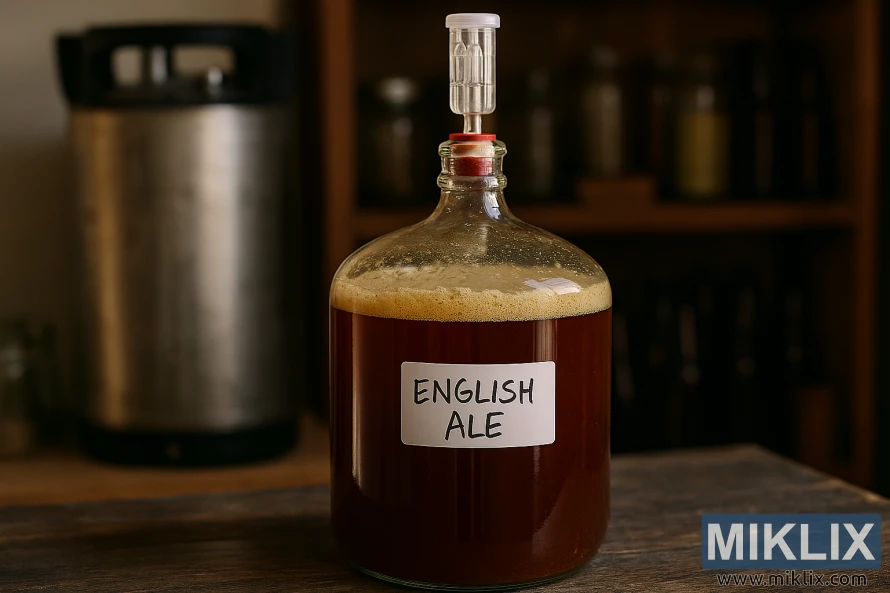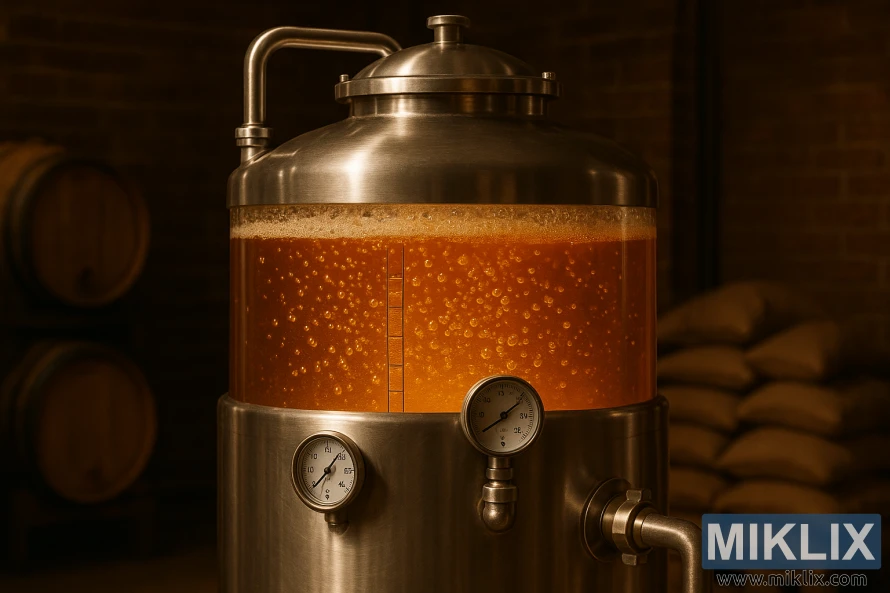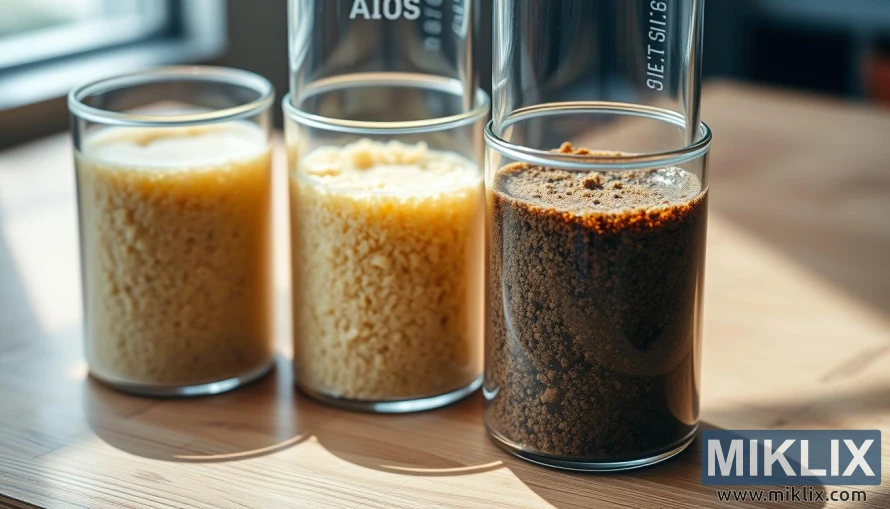Fermenting Beer with Lallemand LalBrew Nottingham Yeast
Published: July 21, 2025 at 2:53:22 PM UTC
Last updated: November 30, 2025 at 1:02:52 AM UTC
The Lallemand LalBrew Nottingham yeast is a top pick for brewers. It's known for its high performance and versatility in fermenting a wide range of ale styles. This yeast strain is celebrated for producing beers with clean and fruity flavors. It's a favorite among brewers aiming to create high-quality ales. In this article, we'll explore the characteristics, optimal brewing conditions, and flavor profile of Lallemand LalBrew Nottingham yeast. We aim to help you grasp its benefits and limitations in your brewing endeavors.

Key Takeaways
- High-performance yeast for ale brewing
- Produces clean and fruity flavors
- Suitable for a wide range of ale styles
- Optimal brewing conditions for best results
- Understanding the yeast's characteristics and limitations
Introduction to Lallemand LalBrew Nottingham
For brewers looking for a dependable and versatile yeast strain, Lallemand LalBrew Nottingham stands out. This English-style ale yeast is chosen for its high performance and adaptability. It's perfect for a wide range of beer styles.
Lallemand LalBrew Nottingham yeast is known for its high flocculation and attenuation properties. These traits are ideal for brewers aiming to produce high-quality beers with minimal effort. Its reliability and consistency make it a favorite among brewers.
The versatility of Lallemand LalBrew Nottingham allows it to be used in various brewing applications. It can be used in traditional English ales or more innovative beer styles. Its high-performance capabilities ensure brewers can achieve their desired flavor profiles and beer characteristics.
Technical Specifications and Characteristics
Understanding the technical specifications of Lallemand LalBrew Nottingham yeast is essential for optimizing the brewing process. This yeast boasts a high flocculation rate of 80-90%. This significantly impacts the clarity and stability of the final beer product.
The attenuation rate of Lallemand LalBrew Nottingham yeast is also noteworthy, ranging from 80-90%. This high attenuation capability ensures the yeast effectively consumes the sugars in the wort. This results in a beer with the desired alcohol content and flavor profile.
- High flocculation rate: 80-90%
- High attenuation rate: 80-90%
- Suitable for a wide range of beer styles
The combination of these characteristics makes Lallemand LalBrew Nottingham yeast a versatile and reliable choice for brewers. Whether brewing pale ales, stouts, or other styles, this yeast's performance is consistent and predictable.
In summary, the technical specifications and characteristics of Lallemand LalBrew Nottingham yeast underscore its value in brewing. Its high flocculation and attenuation rates are key factors that contribute to its popularity among brewers seeking to produce high-quality beers.
Optimal Brewing Conditions
The success of beer fermentation with Lallemand LalBrew Nottingham hinges on optimal brewing conditions. This yeast strain excels in various brewing environments, making it versatile and reliable.
To maximize Lallemand LalBrew Nottingham's performance, brewers must focus on three critical factors. These include fermentation temperature, yeast pitching rate, and nutrient availability.
- Maintain a consistent fermentation temperature between 14°C and 21°C to ensure optimal yeast performance.
- Pitch the yeast at the recommended rate to achieve the desired fermentation characteristics.
- Provide the necessary nutrients for healthy fermentation, including essential amino acids and vitamins.
By controlling these brewing conditions, brewers can enhance the fermentation process. This leads to the production of high-quality beer with consistent flavor profiles. Lallemand LalBrew Nottingham yeast is known for its clean and neutral fermentation character. It is suitable for a wide range of beer styles.
Optimal brewing conditions not only improve the overall quality of the beer but also contribute to a successful fermentation process. By understanding and maintaining these conditions, brewers can unlock the full potency of Lallemand LalBrew Nottingham yeast.

Flavor Profile Analysis
Understanding the flavor profile of Lallemand LalBrew Nottingham yeast is key to achieving desired beer characteristics. This yeast strain is renowned for its neutral flavor profile. This is vital for brewing a wide array of beer styles.
The neutral flavor profile is enhanced by hints of estery and fruity flavors. These add complexity to the beer without dominating its other characteristics. The balance of these flavors results in a clean and crisp finish. This makes Lallemand LalBrew Nottingham yeast ideal for various beer styles.
Key characteristics of the Lallemand LalBrew Nottingham yeast flavor profile include:
- Neutral background flavor
- Hints of estery flavors
- Fruity notes that add complexity
- Clean and crisp finish
Brewers can create beers with a balanced flavor profile using these characteristics. The versatility of Lallemand LalBrew Nottingham yeast makes it a favorite among brewers. They seek to produce high-quality beers with distinct flavor profiles.
Suitable Beer Styles
Brewers can explore a variety of beer styles with Lallemand LalBrew Nottingham. This yeast is perfect for those looking to try different styles without sacrificing quality. It's ideal for creating everything from pale ales to stouts.
The Lallemand LalBrew Nottingham yeast is versatile, suitable for many beer styles. Some of the most popular include:
- Pale Ales
- Ambers
- Stouts
- Porters
These styles benefit from the yeast's ability to ferment at various temperatures. This results in consistent, high-quality beers.
Whether aiming for a hoppy pale ale or a rich stout, Lallemand LalBrew Nottingham yeast is up to the task. It offers the flexibility and performance needed to achieve your desired flavor.
Fermentation Performance Review
Fermentation performance is a critical aspect where Lallemand LalBrew Nottingham yeast excels. This yeast is renowned for its high fermentation rate and efficiency. It's an ideal choice for brewers aiming to produce high-quality beers quickly.
The Lallemand LalBrew Nottingham yeast has been engineered for consistent and reliable fermentation results. Its high yeast efficiency ensures brewers can achieve their desired fermentation outcomes with minimal variability.
Some key benefits of using Lallemand LalBrew Nottingham yeast include:
- High fermentation rates
- Consistent fermentation results
- Ability to produce high-quality beers quickly
In practical brewing scenarios, the Lallemand LalBrew Nottingham yeast has proven to be a valuable asset. It allows brewers to maintain a consistent production schedule while ensuring the quality of their beers.
Overall, the fermentation performance of Lallemand LalBrew Nottingham yeast makes it a top choice among brewers. Its efficiency, consistency, and ability to produce high-quality beers quickly are key factors that contribute to its popularity.
Packaging and Storage Requirements
The Lallemand LalBrew Nottingham yeast demands specific storage conditions to stay effective. Proper handling and storage are key to keeping the yeast viable and performing well.
To preserve the quality of Lallemand LalBrew Nottingham yeast, store it in a cool, dry place. The storage area should be away from direct sunlight and heat sources.
Here are some key considerations for storing Lallemand LalBrew Nottingham yeast:
- Store the yeast in its original packaging until use.
- Keep the yeast away from moisture and humidity.
- Avoid exposing the yeast to extreme temperatures.
- Use the yeast before the expiration date printed on the packaging.
By adhering to these storage guidelines, brewers can ensure their Lallemand LalBrew Nottingham yeast remains effective. This results in consistent fermentation and high-quality beer.
Rehydration and Pitching Techniques
Effective fermentation with Lallemand LalBrew Nottingham yeast begins with proper rehydration and pitching. Rehydrating the yeast in warm water before pitching is essential. This step ensures optimal fermentation performance. It revives yeast cells, making them more viable and active during fermentation.
To rehydrate Lallemand LalBrew Nottingham yeast, brewers must follow a precise method. Add the yeast to warm water (around 25°C to 30°C or 77°F to 86°F) at a 1:10 ratio (1 gram of yeast to 10 milliliters of water). Gently stir the mixture to distribute the yeast evenly. Then, let it stand for 15 to 30 minutes. This allows the yeast cells to rehydrate fully before being pitched into the wort.
Pitching the rehydrated yeast into the wort must be done carefully to avoid shocking the yeast cells. The wort temperature should be close to the yeast rehydration temperature to minimize thermal shock. Gentle agitation or aeration of the wort before pitching can also help in achieving a healthy fermentation.
Some key considerations for pitching include ensuring that the wort is adequately oxygenated. Lallemand LalBrew Nottingham yeast benefits from sufficient oxygen levels for healthy growth and fermentation. Pitching at the correct rate is also critical; under-pitching can lead to stressed yeast and off-flavors, while over-pitching can result in overly rapid fermentation and flavor losses.
- Rehydrate yeast in warm water (25°C - 30°C or 77°F - 86°F).
- Use a 1:10 ratio of yeast to water.
- Allow the mixture to stand for 15 to 30 minutes.
- Pitch rehydrated yeast into wort at a similar temperature.
- Ensure adequate oxygenation of the wort before pitching.
By following these guidelines for rehydration and pitching, brewers can optimize the performance of Lallemand LalBrew Nottingham yeast. This leads to consistent and high-quality fermentation results.
Comparison with Other Ale Yeasts
Choosing the right yeast strain is essential in brewing. Comparing Lallemand LalBrew Nottingham yeast with other popular ale yeasts helps brewers make better decisions. Lallemand LalBrew Nottingham yeast is often compared to Lallemand LalBrew Windsor yeast due to their similarities and differences in brewing performance.
Lallemand LalBrew Nottingham yeast is known for its neutral flavor profile. This makes it versatile for brewing various ale styles. In contrast, other ale yeasts may impart more pronounced flavors. For example, Lallemand LalBrew Windsor yeast produces beers with fruitier and more estery flavors compared to Lallemand LalBrew Nottingham.
Several factors are considered when comparing these yeasts. These include fermentation temperature, attenuation levels, and the overall impact on the beer's flavor and aroma. Lallemand LalBrew Nottingham yeast ferments well at temperatures between 18°C to 20°C (64°F to 68°F). This is typical for many ale fermentations.
- Lallemand LalBrew Nottingham yeast offers a clean fermentation profile.
- It is suitable for a wide range of ale styles.
- The yeast provides consistent attenuation and reliable results.
In comparison to other ale yeasts, Lallemand LalBrew Nottingham stands out for its reliability and neutral character. Brewers should consider their specific brewing goals and the style of beer they are producing when choosing between different yeast strains.
The choice between Lallemand LalBrew Nottingham and other ale yeasts depends on the brewer's preferences and desired beer characteristics. By understanding the strengths and weaknesses of each yeast strain, brewers can make more informed decisions to achieve their brewing objectives.

Cost-Effectiveness Analysis
Brewers aiming to enhance their brewing efficiency often focus on the cost-effectiveness of Lallemand LalBrew Nottingham yeast. This yeast is celebrated for its exceptional fermentation efficiency. This efficiency plays a critical role in reducing the overall brewing costs.
The cost-effectiveness of Lallemand LalBrew Nottingham yeast stems from its versatility and superior performance. It is compatible with a broad spectrum of beer styles. This versatility makes it an invaluable resource for breweries that diversify their offerings. The yeast's consistent ability to produce high-quality fermentation outcomes minimizes the necessity for re-brews. This not only saves time but also conserves resources.
- High fermentation efficiency reduces yeast cost per batch.
- Versatility in brewing various beer styles without compromising quality.
- Consistent performance minimizes the need for re-brews.
In assessing cost-effectiveness, brewers must weigh the yeast's cost, its fermentation efficiency, and its adaptability to different brewing conditions. Lallemand LalBrew Nottingham yeast excels in these aspects, positioning it as a cost-effective choice.
Common Brewing Challenges and Solutions
To achieve optimal fermentation performance with Lallemand LalBrew Nottingham yeast, brewers must first identify and tackle common brewing challenges.
One of the primary concerns when brewing with Lallemand LalBrew Nottingham yeast is yeast-related issues, such as under-pitching and over-pitching. Under-pitching can lead to incomplete fermentation, resulting in off-flavors and inconsistent beer quality. On the other hand, over-pitching can cause stress to the yeast, potentially leading to undesirable flavor profiles.
Effective troubleshooting strategies are essential for minimizing the risk of fermentation problems. Here are some common brewing challenges and their corresponding solutions:
- Under-pitching: Ensure accurate pitching rates by using a hemocytometer or an automated cell counter.
- Over-pitching: Monitor yeast viability and adjust pitching rates to avoid over-stressing the yeast.
- Temperature fluctuations: Maintain consistent fermentation temperatures to prevent stressing the yeast.
By understanding the causes of these brewing challenges and implementing the right solutions, brewers can optimize their fermentation processes. This will help produce high-quality beers with Lallemand LalBrew Nottingham yeast.
Regular monitoring and maintenance of brewing equipment, along with adherence to best brewing practices, can also help mitigate issues.
Professional Brewer Testimonials
Professional brewers have shared their experiences with Lallemand LalBrew Nottingham yeast. They highlight its efficiency and versatility in brewing. Many have reported that this yeast strain has improved their fermentation processes. This has resulted in consistent and high-quality beers.
The Lallemand LalBrew Nottingham yeast has garnered attention from professional brewers. They praise its performance in various brewing applications. Its ability to produce clean, crisp flavors has made it a favorite among brewers looking to create traditional ale styles.
- Reliable fermentation performance
- Consistent flavor profiles
- Versatility in brewing applications
Brewer testimonials indicate a strong satisfaction rate with Lallemand LalBrew Nottingham yeast. They cite its reliability and consistency. By incorporating the insights and experiences of professional brewers, we can better understand the benefits and applications of this yeast strain in various brewing contexts.

Batch Size Recommendations
Batch size is a key factor in achieving the desired fermentation with Lallemand LalBrew Nottingham yeast. The ideal batch size varies based on several factors. These include the yeast pitching rate and the beer style being brewed.
To find the optimal batch size, brewers must consider the yeast pitching rate. This rate is the number of yeast cells added to the wort per unit of volume. A higher pitching rate can lead to faster fermentation but may increase the risk of over-attenuation. On the other hand, a lower pitching rate can result in slower fermentation, potentially causing under-attenuation.
For most beer styles, a batch size between 5-10 hectoliters is recommended. Yet, this can change based on the brewery's specific needs and the beer being produced. For instance, larger batch sizes might be more suitable for high-gravity beers. Smaller batch sizes could be better for session beers.
- Consider the yeast pitching rate when determining batch size.
- Adjust batch size according to the specific beer style.
- Monitor fermentation performance to ensure optimal results.
By carefully planning the batch size and yeast pitching rate, brewers can optimize their fermentation performance. This allows them to produce high-quality beers with Lallemand LalBrew Nottingham yeast.
Environmental Impact and Sustainability
Lallemand LalBrew Nottingham yeast is made with eco-friendly practices. The production aims to cut down on waste and save resources. This aligns with the goals of brewers who care about the environment.
The sustainability of Lallemand's methods is evident in several areas:
- Efficient water usage during the production process
- Implementation of waste reduction strategies
- Use of renewable energy sources where possible
Choosing LalBrew Nottingham yeast helps brewers support a greener brewing industry. This yeast strain ensures high-quality beer while promoting eco-friendly brewing.
Using Lallemand LalBrew Nottingham yeast offers several advantages:
- Reduced carbon footprint due to efficient production processes
- Support for brewers in achieving their sustainability goals
- Consistent fermentation performance, reducing the need for re-brews
Lallemand's dedication to sustainability makes LalBrew Nottingham yeast a top choice for environmentally conscious brewers.
Quality Control Measures
Lallemand LalBrew Nottingham yeast undergoes rigorous testing to guarantee its quality. Ensuring the purity and viability of this yeast is critical for optimal fermentation performance in brewing.
The quality control process for Lallemand LalBrew Nottingham involves several key steps. These include:
- Microbiological testing to detect any contamination
- Viability testing to ensure the yeast is alive and capable of fermenting
- Purity testing to verify the yeast strain is consistent and uncontaminated
By implementing these rigorous quality control measures, brewers can minimize the risk of fermentation problems. This results in better beer quality. The Lallemand LalBrew Nottingham yeast is produced under strict guidelines to ensure its performance and consistency.
Maintaining high yeast quality is essential for producing high-quality beers. Lallemand's commitment to quality control ensures that LalBrew Nottingham yeast performs consistently, batch after batch.

Where to Buy LalBrew Nottingham
Lallemand LalBrew Nottingham yeast is available through various distributors and suppliers across the United States. Brewers can easily find this yeast through online retailers and homebrew stores. This ensures a steady supply of high-quality yeast for their brewing projects.
Some popular places to buy Lallemand LalBrew Nottingham yeast include:
- Online homebrew supply stores
- Local homebrew shops
- Brewery supply distributors
When choosing a supplier or distributor, brewers should do their research. This is to ensure they buy from a reputable source. This step is critical to guarantee the quality and authenticity of the yeast.
Conclusion
Lallemand LalBrew Nottingham yeast stands out as a versatile and dependable option for brewers. It's perfect for a broad spectrum of beer styles. Its high fermentation efficiency and neutral taste make it ideal for crafting top-notch beers.
By adhering to the recommended brewing methods and troubleshooting tips in this review, brewers can enhance their use of Lallemand LalBrew Nottingham. This ensures optimal fermentation results. Its minimal environmental impact also appeals to eco-conscious brewers.
In summary, Lallemand LalBrew Nottingham is a top pick for brewers looking for a reliable and efficient yeast strain. Its versatility and performance make it suitable for various brewing needs. It's definitely worth considering for your next brewing endeavor.
Further Reading
If you enjoyed this post, you may also like these suggestions:
- Fermenting Beer with White Labs WLP001 California Ale Yeast
- Fermenting Beer with Mangrove Jack's M36 Liberty Bell Ale Yeast
- Fermenting Beer with White Labs WLP540 Abbey IV Ale Yeast
